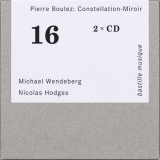 Constellation-Miroir; Pierre Boulez: Sämtliche Klavierwerke; Notations + Klaviersonaten Nr. 1-3 + Lent - Beaucoup plus allant (Erstfassung aus Klaviersonate Nr. 1) + Structures I & II für 2 Klaviere + Formant 1 (Fragment aus Klaviersonate Nr. 3) + Chapitre aus Structures II (alternative Version) + Fragment d'une ébauche; Incises + Une page d'éphémeride; Nicolas Hodges, Michael Wendeberg, Klavier; 2 CDs Bastille Musique bm16; Aufnahmen 2018-2020, Veröffentlichung 01/2021 (159'33) – Rezension von Remy Franck
Constellation-Miroir; Pierre Boulez: Sämtliche Klavierwerke; Notations + Klaviersonaten Nr. 1-3 + Lent - Beaucoup plus allant (Erstfassung aus Klaviersonate Nr. 1) + Structures I & II für 2 Klaviere + Formant 1 (Fragment aus Klaviersonate Nr. 3) + Chapitre aus Structures II (alternative Version) + Fragment d'une ébauche; Incises + Une page d'éphémeride; Nicolas Hodges, Michael Wendeberg, Klavier; 2 CDs Bastille Musique bm16; Aufnahmen 2018-2020, Veröffentlichung 01/2021 (159'33) – Rezension von Remy Franck
Aufnahmen mit Klaviermusik von Pierre Boulez gibt es etliche, und es ist gut, nach den Einspielungen der Kontarsky-Brüder, von Aimard, Pollini und Ponthus eine neue Sicht auf das Solo-Klavierwerk und die beiden Zyklen Structures für zwei Klaviere zu bekommen. Michael Wendeberg ist der Hauptinterpret, Nicolas Hodges sitzt in Structures am 2. Klavier.
Sie erkunden das Klavierwerk chronologisch, von Douze Notations (1945) bis zu Une page d’éphéméride (2005). Die meisten der Werke entstanden allerdings in den Vierziger, Fünfziger- und frühen Sechzigerjahren, während der radikalsten Phase in Boulez’ kompositorischer Entwicklung. Laut dem Pianisten Charles Rosen war das Klavier für Boulez « ein traditionelles Ventil für Experimente », es erlaubte « eine unmittelbare Kontrolle über die musikalische Idee », eine, die « oft gleichzeitig die Natur der Revolution anzeigt und ihre Grenzen andeutet. » Diese Grenzen wurden mit der Dritten Sonate erreicht und setzten einen vorläufigen Schlusspunkt.
Michael Wendeberg und Nicolas Hodges gelingen durchgehend interessante Interpretationen, weil sie sich nicht nur auf die geschriebenen Noten verlassen, sondern den Stücken, so kurz die Sätze manchmal auch sein mögen, wirkliches Leben einhauchen. Wo andere glaubten, der Radikalität des Materials mit ebenso radikalem Spiel begegnen zu müssen, sprengen die beiden Pianisten mit einer außergewöhnlichen Palette von Farben und dynamischen Nuancen, mit ungemein viel Spontaneität und Präsenz sowie einer großartigen Phrasierungskunst den Rahmen der manchmal wirklich kargen Struktur.
Selbst die kleinen Teilchen heizen sich dabei auf wie Steine am Strand in der brütenden Sonne. In den frühen Werken, etwa den Douze Notations, aber selbst noch in Incises dringt sogar etwas Emotion in Wendebergs sensibles, singendes Spiel.
There are quite a few recordings of Pierre Boulez’s piano music, and, after the recordings by the Kontarsky brothers, Aimard, Pollini and Ponthus, it is good to get a new perspective on the solo piano work and the two cycles Structures for two pianos. Michael Wendeberg is the principal performer, with Nicolas Hodges at 2nd piano in Structures.They explore the piano works chronologically, from Douze Notations (1945) to Une page d’éphéméride (2005). Most of the works, however, were composed in the Forties, Fifties, and early Sixties, during the most radical phase in Boulez’s compositional development. According to pianist Charles Rosen, the piano was for Boulez « a traditional outlet for experimentation, » allowing « an immediate control over the musical idea, » one that « often simultaneously indicates the nature of the revolution and hints at its limits. » Those limits were reached with the Third Sonata, providing a tentative conclusion.Michael Wendeberg and Nicolas Hodges succeed in consistently interesting interpretations because they don’t just rely on the written notes, but breathe real life into the pieces, however short the movements may sometimes be. Where others thought they had to counter the radical nature of the material with equally radical playing, the two pianists go beyond the sometimes truly barren structure with an extraordinary palette of colors and dynamic nuances, with an immense amount of spontaneity and presence, and with a superb art of phrasing.Even the small pieces heat up like stones on the beach in the brooding sun. In the early works, such as the Douze Notations, but even in Incises some emotion penetrates Wendeberg’s sensitive, singing playing.






















